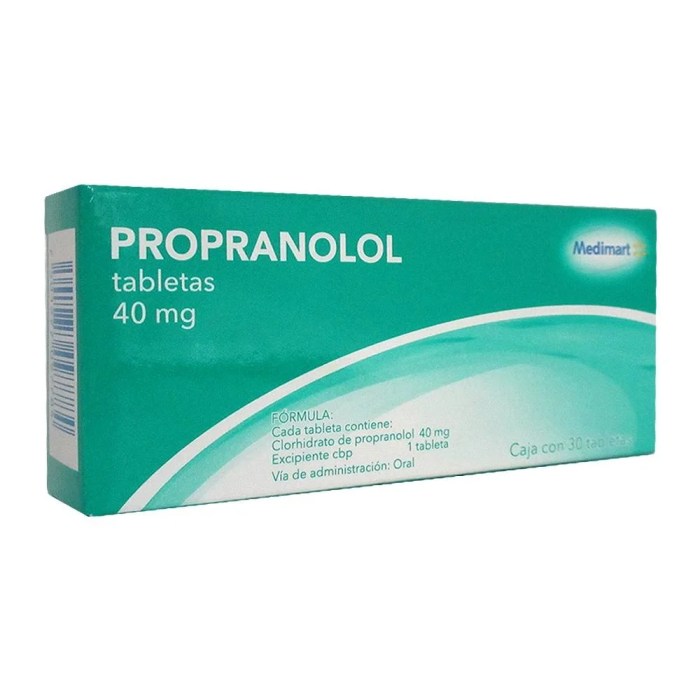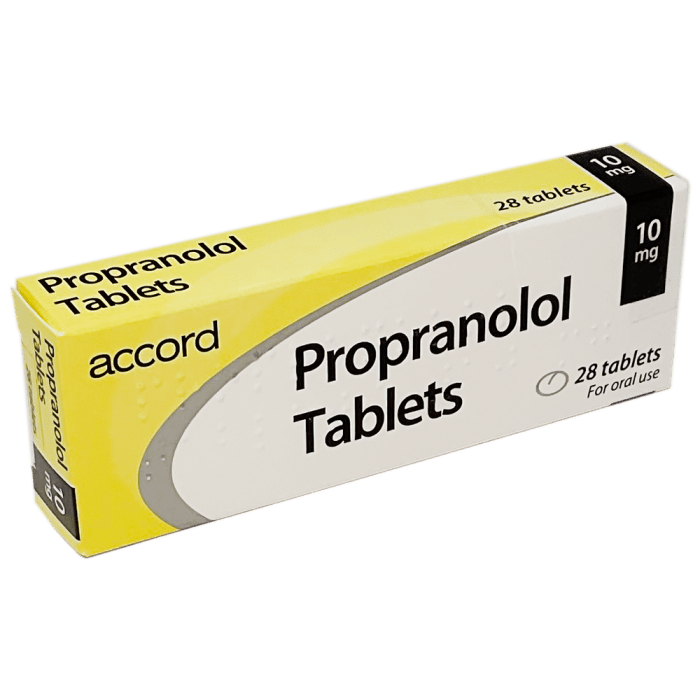Propranolol, a beta-blocker medication, has a long history of use in treating a wide range of medical conditions, from cardiovascular diseases to anxiety disorders. It works by blocking the effects of adrenaline, a hormone that plays a role in heart rate and blood pressure. This action helps to reduce anxiety, slow down the heart rate, and lower blood pressure. Propranolol is available in different formulations, including immediate-release and extended-release, each tailored to specific needs.
Understanding propranolol’s mechanism of action, therapeutic uses, and potential side effects is crucial for patients and healthcare professionals alike. This guide aims to provide a comprehensive overview of propranolol, covering its pharmacokinetics, interactions with other medications, and implications for pregnancy and lactation.
Propranolol and Alcohol

Propranolol is a beta-blocker medication commonly used to treat conditions like high blood pressure, heart rhythm problems, and anxiety. Alcohol, on the other hand, is a depressant that can affect various bodily functions, including the heart and central nervous system. When taken together, propranolol and alcohol can interact in ways that could pose risks to your health.
Interactions Between Propranolol and Alcohol
The combination of propranolol and alcohol can lead to several interactions, some of which can be dangerous. These interactions are primarily due to the fact that both substances affect the heart and central nervous system, albeit in different ways.
- Increased Risk of Low Blood Pressure: Both propranolol and alcohol can lower blood pressure. When taken together, they can cause an excessive drop in blood pressure, leading to dizziness, lightheadedness, and fainting.
- Heart Rate Changes: Propranolol slows down the heart rate. Alcohol can also affect heart rhythm, potentially leading to irregular heartbeat or even a slower heart rate. This combination can increase the risk of bradycardia (slow heart rate), which can be dangerous.
- Increased Sedation and Drowsiness: Both propranolol and alcohol have sedative effects. Combining them can lead to excessive drowsiness, impaired coordination, and difficulty concentrating.
- Increased Risk of Liver Damage: While propranolol is generally safe for the liver, excessive alcohol consumption can damage the liver. Combining the two can potentially increase the risk of liver problems.
Risks of Combining Propranolol with Alcohol
The risks associated with combining propranolol and alcohol vary depending on several factors, including the dosage of propranolol, the amount of alcohol consumed, and the individual’s health condition.
- Severe Hypotension (Low Blood Pressure): This can lead to dizziness, lightheadedness, and fainting. In severe cases, it can even lead to shock.
- Bradycardia (Slow Heart Rate): This can be dangerous, especially for individuals with pre-existing heart conditions.
- Respiratory Depression: This is a potentially life-threatening condition where breathing becomes shallow and slow.
- Increased Risk of Falls and Accidents: The combined sedative effects of propranolol and alcohol can impair coordination and judgment, increasing the risk of falls and accidents.
- Drug Interactions: Some medications interact with both propranolol and alcohol, potentially increasing the risk of side effects.
Propranolol and Other Medications
Propranolol, a beta-blocker, can interact with a variety of other medications, potentially leading to adverse effects. It’s crucial to inform your doctor about all medications you’re taking, including over-the-counter drugs, supplements, and herbal remedies, to minimize the risk of interactions.
Potential Drug Interactions
It’s essential to be aware of potential drug interactions with propranolol. These interactions can range from mild to severe, depending on the medications involved. The following table lists some common medications that may interact with propranolol:
| Medication Class | Example Medications | Potential Interactions |
|---|---|---|
| Antiarrhythmics | Quinidine, Amiodarone, Digoxin | Increased risk of bradycardia (slow heart rate) and heart block |
| Antihypertensives | Clonidine, Methyldopa, Hydralazine | Enhanced hypotensive effects (low blood pressure) |
| Antidepressants | MAOIs (Monoamine Oxidase Inhibitors), Tricyclic Antidepressants | Increased risk of hypotension, bradycardia, and other adverse effects |
| Antibiotics | Erythromycin, Clarithromycin | Increased propranolol levels, leading to enhanced effects |
| Asthma Medications | Albuterol, Salmeterol | Propranolol can block the bronchodilating effects of these medications |
| Other Medications | Insulin, Oral Hypoglycemics, Warfarin, Theophylline | Potential for various interactions, including altered blood sugar levels, increased bleeding risk, and decreased theophylline effectiveness |
Managing Drug Interactions
To minimize the risk of drug interactions, it’s essential to:
- Be open and honest with your doctor about all medications you’re taking, including over-the-counter drugs, supplements, and herbal remedies.
- Ask your doctor about potential interactions before starting any new medication.
- Monitor your blood pressure, heart rate, and other vital signs regularly, especially when starting a new medication.
- Report any unusual symptoms or side effects to your doctor promptly.
Remember, your doctor is your best resource for managing drug interactions. Always consult with them before making any changes to your medication regimen.
Propranolol and Lifestyle Modifications
Propranolol, a beta-blocker medication, is often prescribed for conditions like high blood pressure, anxiety, and migraines. While medication plays a crucial role in managing these conditions, lifestyle changes can significantly enhance the effectiveness of propranolol and minimize potential risks associated with its use.
Lifestyle Modifications for Enhanced Propranolol Effectiveness
Lifestyle modifications can play a crucial role in optimizing the benefits of propranolol. By adopting a healthy lifestyle, individuals can enhance the medication’s effectiveness and potentially reduce the need for higher dosages.
- Regular Exercise: Physical activity can lower blood pressure and improve heart health, complementing the effects of propranolol. Aim for at least 30 minutes of moderate-intensity exercise most days of the week.
- Balanced Diet: A diet rich in fruits, vegetables, and whole grains can help manage weight, lower blood pressure, and improve overall health. Limiting processed foods, saturated fats, and added sugars is essential.
- Weight Management: Obesity can increase the risk of heart disease and high blood pressure. Maintaining a healthy weight can enhance the effectiveness of propranolol in managing these conditions.
- Stress Management: Chronic stress can elevate blood pressure and worsen anxiety. Techniques like yoga, meditation, or deep breathing exercises can help manage stress and improve overall well-being.
- Quit Smoking: Smoking significantly increases the risk of heart disease and stroke. Quitting smoking can improve cardiovascular health and enhance the benefits of propranolol.
- Alcohol Moderation: Excessive alcohol consumption can interfere with the effectiveness of propranolol and increase the risk of side effects. Limiting alcohol intake is crucial.
Future Directions in Propranolol Research

Propranolol, a beta-blocker medication, has been a mainstay in treating various conditions for decades. While its efficacy and safety profile are well-established, ongoing research continues to explore new applications and refine its use. This section will delve into the exciting frontiers of propranolol research, highlighting current research areas, potential new applications, and the development of novel formulations.
Current Research Areas
Current research on propranolol focuses on expanding its therapeutic potential beyond its traditional uses. Researchers are actively investigating its role in various medical fields, including:
- Neurological Disorders: Studies are examining propranolol’s potential in treating conditions like anxiety, PTSD, and even Alzheimer’s disease. For example, researchers are investigating its ability to modulate brain activity and reduce the severity of anxiety symptoms in individuals with PTSD.
- Cancer Treatment: Propranolol’s potential in cancer therapy is being explored. Some studies suggest it may inhibit tumor growth and enhance the effectiveness of conventional cancer treatments. For example, researchers are investigating its use in combination with chemotherapy for breast cancer.
- Cardiovascular Health: Research is exploring propranolol’s potential in preventing cardiovascular disease. Some studies suggest it may protect against heart attacks and strokes by reducing blood pressure and improving heart function. For example, researchers are investigating its role in reducing the risk of heart disease in individuals with high blood pressure.
Potential New Applications
The potential applications of propranolol are expanding beyond its traditional uses. Research is exploring its role in:
- Migraine Prevention: Propranolol has shown promise in preventing migraine headaches, and researchers are investigating its long-term efficacy and safety in this context. For example, some studies suggest that propranolol can reduce the frequency and severity of migraine attacks in individuals with chronic migraines.
- Treatment of Tremors: Propranolol is already used to treat essential tremor, and research is exploring its potential in treating other types of tremors, such as those associated with Parkinson’s disease. For example, some studies suggest that propranolol can reduce the severity of tremors in individuals with Parkinson’s disease.
- Cosmetic Applications: Propranolol’s potential in cosmetic applications is being explored. Some studies suggest it may reduce facial redness and improve skin texture. For example, researchers are investigating its use in topical formulations for treating rosacea and other skin conditions.
Novel Propranolol Formulations
Researchers are actively developing novel propranolol formulations to enhance its delivery, efficacy, and patient compliance. These advancements include:
- Extended-Release Formulations: Extended-release formulations of propranolol aim to provide sustained drug levels for longer durations, reducing the need for frequent dosing. For example, some extended-release formulations of propranolol are available for treating high blood pressure and migraine headaches.
- Targeted Drug Delivery: Research is exploring targeted drug delivery systems for propranolol to deliver the medication directly to the affected tissues or organs. For example, researchers are investigating the use of nanoparticles to deliver propranolol specifically to the brain for treating neurological disorders.
- Combination Therapies: Combining propranolol with other medications is being explored to enhance its therapeutic effects. For example, researchers are investigating the combination of propranolol with other drugs for treating heart failure and cancer.
Propranolol remains a vital medication in modern medicine, offering a valuable tool for managing various conditions. Understanding its intricacies, from its mechanism of action to potential side effects, empowers both patients and healthcare providers to make informed decisions regarding its use. While propranolol offers significant benefits, it’s essential to be aware of its potential interactions with other medications and lifestyle factors that can influence its effectiveness. This comprehensive guide serves as a valuable resource for navigating the complexities of propranolol, promoting safe and effective use for optimal health outcomes.
Propranolol, a beta-blocker commonly used to treat high blood pressure and anxiety, is a far cry from the cutting-edge cancer immunotherapy drug Keytruda. Keytruda, a checkpoint inhibitor, works by boosting the body’s immune system to fight cancer cells. While both medications are effective in their respective areas, the mechanisms of action and therapeutic targets differ significantly.